
home •
about •
essential guide •
picture of the day •
thunderblogs •
news •
multimedia •
predictions •
products •
get involved •
contact
picture of the day archive subject index
Credit: Jane C. Charlton (Penn State ) et al., HST, ESA, NASA
Apr 26, 2007
Ultra Luminous Astronomy (2)In yesterday's Picture of the Day, we looked at ULIRG's -- Ultra Luminous Infra Red Galaxies. From the viewpoint of astronomer Halton Arp's intrinsic redshift, these are galaxies whose luminosity has been bloated from "normal" or "under luminous" to "ultra luminous" because they are believed to be much farther away than they actually are.
Today we will look at ULX's -- Ultra Luminous X-ray objects. The distance of these objects is not in question -- they lie within the disk of galaxies whose distances are known. The problem is that they give off more x-rays than anything known to reside inside a galaxy, even a supernova explosion. Astronomical speculation suggests that they must be binary systems with a black hole and a normal star orbiting together.
However, on the night of October 2, 2003, a group of astronomers took the spectrum of the ULX in the above Hubble Telescope photo of Stephan's Quintet (the ULX is the tiny bright spot indicated by the arrow). That spectrum showed a redshift that identified the ULX as a high redshift quasar, something that belongs far in the background of a big bang universe, but is right where it belongs in an intrinsic redshift universe. Halton Arp, who has been ostracized for 30 years for criticizing the big bang, said, " ... nothing could convey the excitement of sitting in the Keck10 meter control room and seeing that beautiful z = 2.11 [high redshift] spectrum unfold on the screen." This is the most direct evidence yet that the redshift = distance relationship doesn't work. [And without the redshift = distance relationship, the big bang also fails.] Arp concluded that most, if not all, of the ULX's will turn out to be nearby quasars in the process of being ejected from active galaxies.
Arp's colleague, Geoffrey Burbidge, designed a test of Arp's hypothesis. He looked at 24 quasars that are unusually close to active galaxies. If he pretended that he didn't know that they were quasars (that is, he pretended that he didn't know they had a high redshift), then all 24 of them met all of the criteria of "standard" ULX's.
The only question left is how long it will take for cosmologists everywhere to realize that the big bang was a big fizzle? It's a whole new universe out there.
![]()
home •
thunderblogs •
forum •
picture of the day •
resources •
team •
updates •
contact us
EXECUTIVE EDITORS:
David Talbott, Wallace Thornhill
MANAGING EDITORS:
Steve Smith, Mel Acheson
CONTRIBUTING EDITORS: Michael Armstrong, Dwardu Cardona,
Ev Cochrane,
C.J. Ransom, Don Scott, Rens van der Sluijs, Ian Tresman
WEBMASTER: Brian Talbott
Copyright 2007: thunderbolts.info
